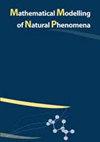隔离和接触者追踪在遏制COVID-19流行中的有效性的数学评估
IF 2.1
4区 数学
Q2 MATHEMATICAL & COMPUTATIONAL BIOLOGY
引用次数: 9
摘要
在我们的COVID-19流行模型中,感染者可以分为四种类型,根据他们是无症状($A$)还是有症状($I$),并使用接触者追踪手机应用程序($Y$)或不使用($N$)。我们用f表示A的分数,用y表示y的分数,用R_0表示随机感染个体的二次感染的平均数量。我们研究了非数字干预和数字干预的影响,这取决于隔离的意愿,由四个合作概率参数化。对于通过非数字干预获得的给定“有效”R_0$,我们使用非负矩阵理论和停止线技术从数学上表征控制疫情所需的应用程序用户的最小分数y_0$。我们表明,在广泛的场景下,阈值$y_0$作为$R_0$的函数从$R_0=1$时的0急剧上升到$R_0$高于1.3时的令人望而却步的大值(约为$60- 70%)。我们的研究结果表明,适度采用接触追踪应用程序可以降低R_0,但绝不足以将其降低到1以下,除非由于非数字干预,R_0已经非常接近1。本文章由计算机程序翻译,如有差异,请以英文原文为准。
A mathematical assessment of the efficiency of quarantining and contact tracing in curbing the COVID-19 epidemic
In our model of the COVID-19 epidemic, infected individuals can be of four types, according whether they are asymptomatic ($A$) or symptomatic ($I$), and use a contact tracing mobile phone app ($Y$) or not ($N$). We denote by $f$ the fraction of $A$'s, by $y$ the fraction of $Y$'s and by $R_0$ the average number of secondary infections from a random infected individual.
We investigate the effect of non-digital interventions and of digital interventions, depending on the willingness to quarantine, parameterized by four cooperating probabilities.
For a given `effective' $R_0$ obtained with non-digital interventions, we use non-negative matrix theory and stopping line techniques to characterize mathematically the minimal fraction $y_0$ of app users needed to curb the epidemic. We show that under a wide range of scenarios, the threshold $y_0$ as a function of $R_0$ rises steeply from 0 at $R_0=1$ to prohibitively large values (of the order of $60-70\%$ up) whenever $R_0$ is above 1.3. Our results show that moderate rates of adoption of a contact tracing app can reduce $R_0$ but are by no means sufficient to reduce it below 1 unless it is already very close to 1 thanks to non-digital interventions.
求助全文
通过发布文献求助,成功后即可免费获取论文全文。
去求助
来源期刊

Mathematical Modelling of Natural Phenomena
MATHEMATICAL & COMPUTATIONAL BIOLOGY-MATHEMATICS, INTERDISCIPLINARY APPLICATIONS
CiteScore
5.20
自引率
0.00%
发文量
46
审稿时长
6-12 weeks
期刊介绍:
The Mathematical Modelling of Natural Phenomena (MMNP) is an international research journal, which publishes top-level original and review papers, short communications and proceedings on mathematical modelling in biology, medicine, chemistry, physics, and other areas. The scope of the journal is devoted to mathematical modelling with sufficiently advanced model, and the works studying mainly the existence and stability of stationary points of ODE systems are not considered. The scope of the journal also includes applied mathematics and mathematical analysis in the context of its applications to the real world problems. The journal is essentially functioning on the basis of topical issues representing active areas of research. Each topical issue has its own editorial board. The authors are invited to submit papers to the announced issues or to suggest new issues.
Journal publishes research articles and reviews within the whole field of mathematical modelling, and it will continue to provide information on the latest trends and developments in this ever-expanding subject.
 求助内容:
求助内容: 应助结果提醒方式:
应助结果提醒方式:


